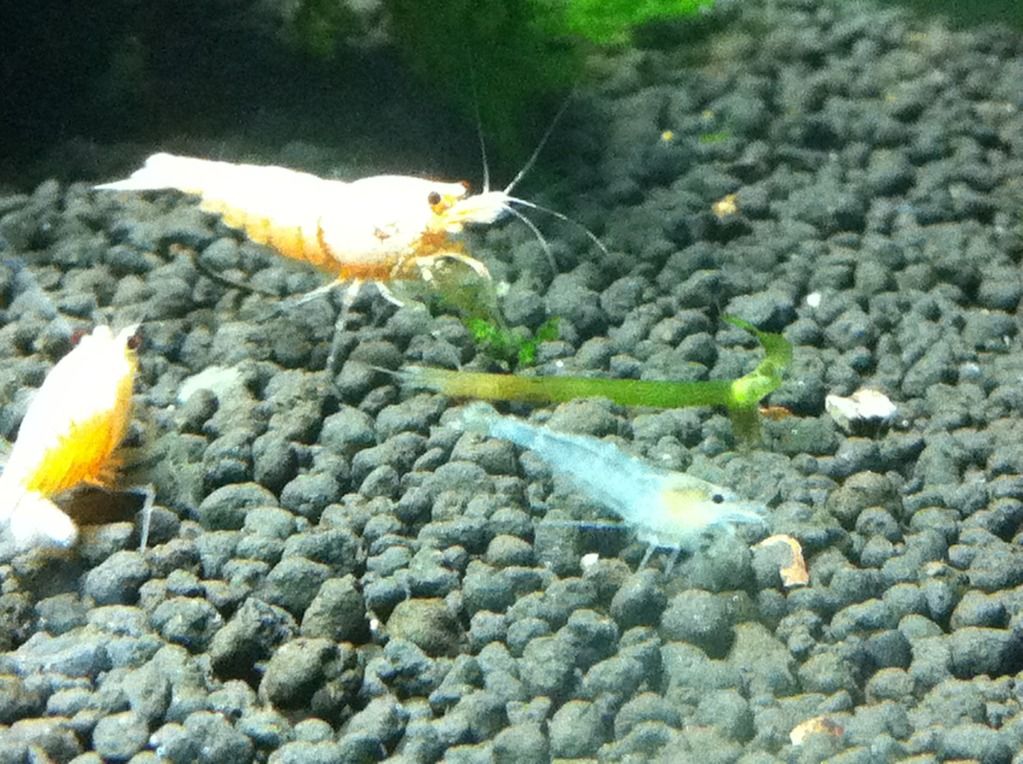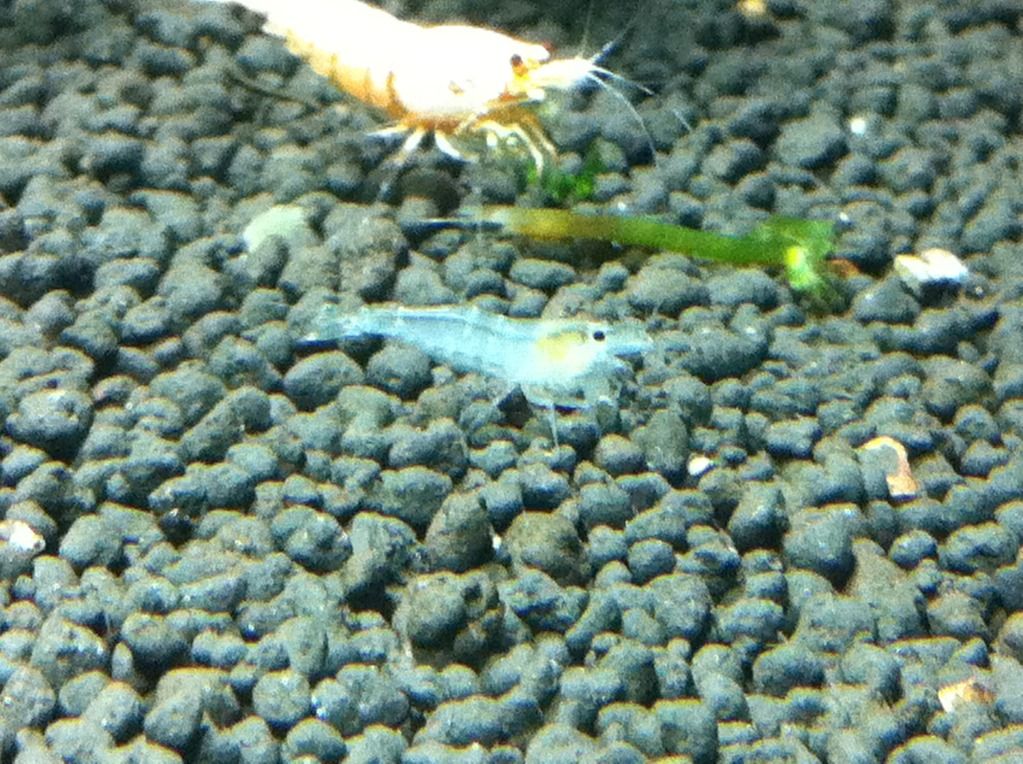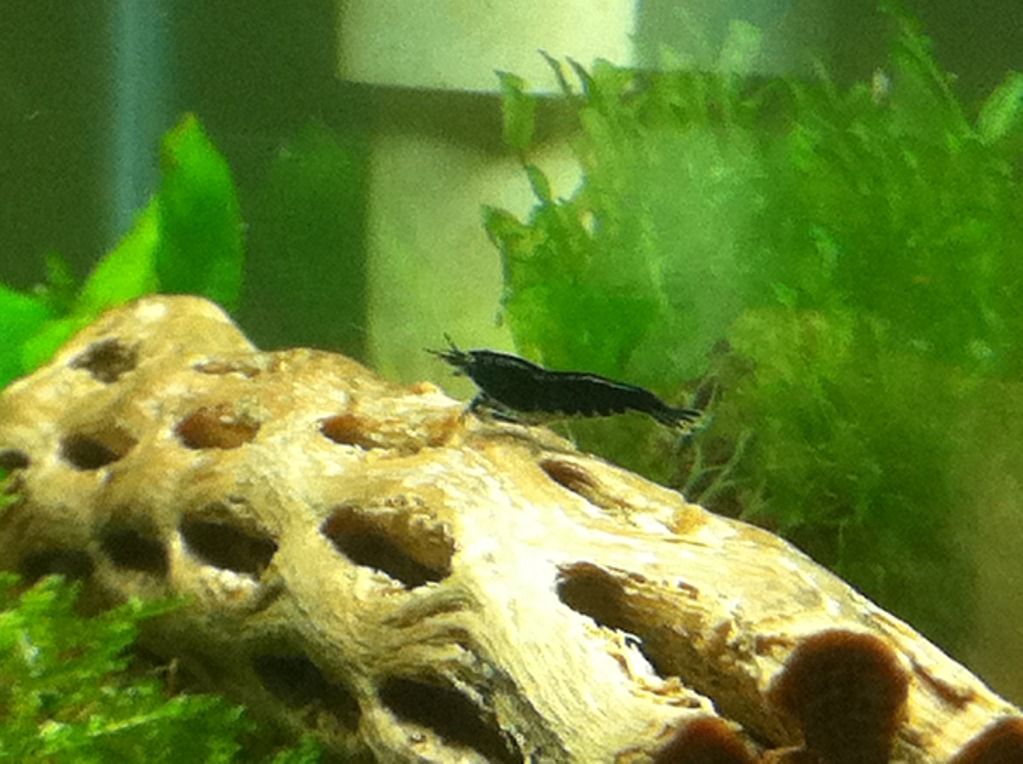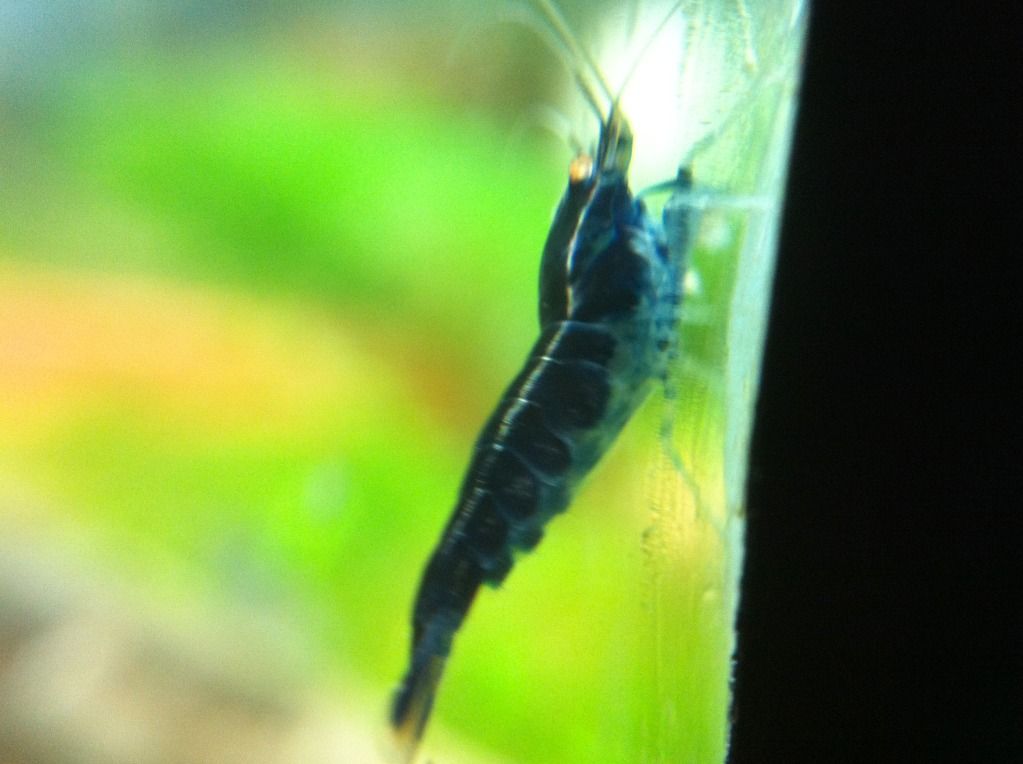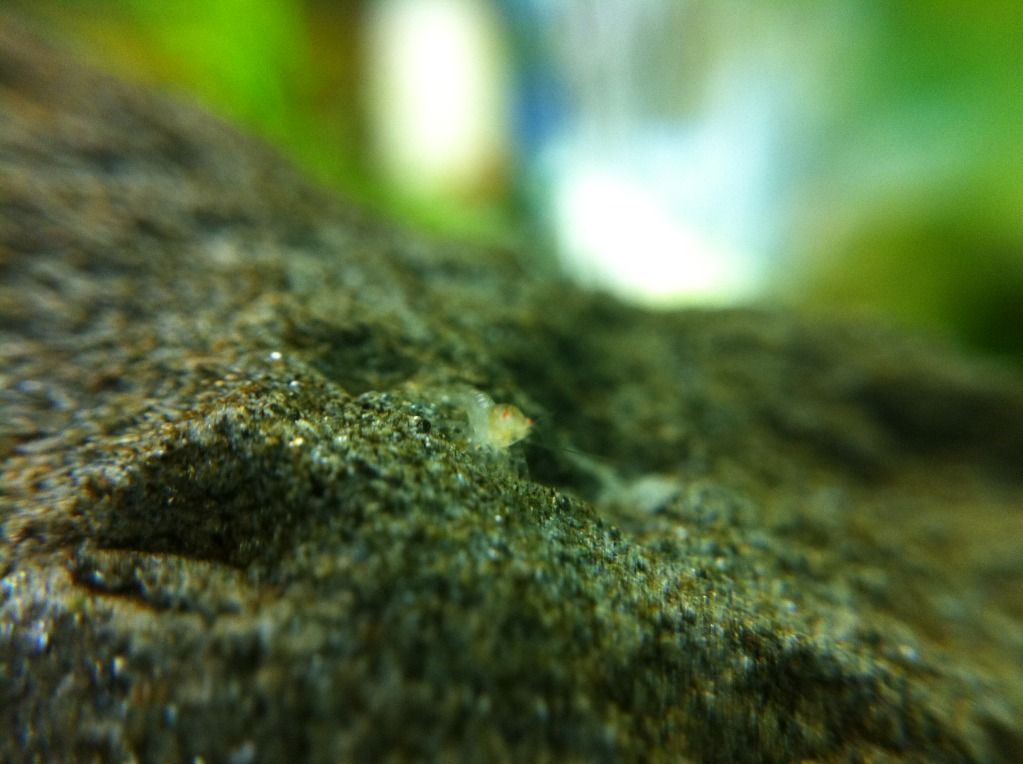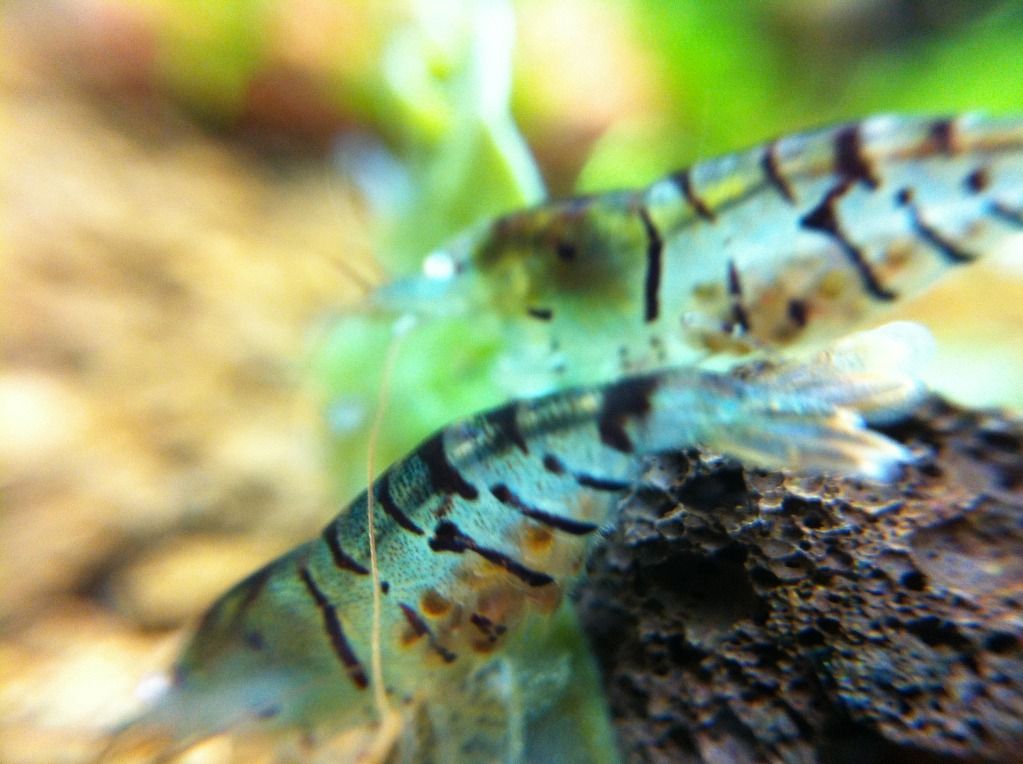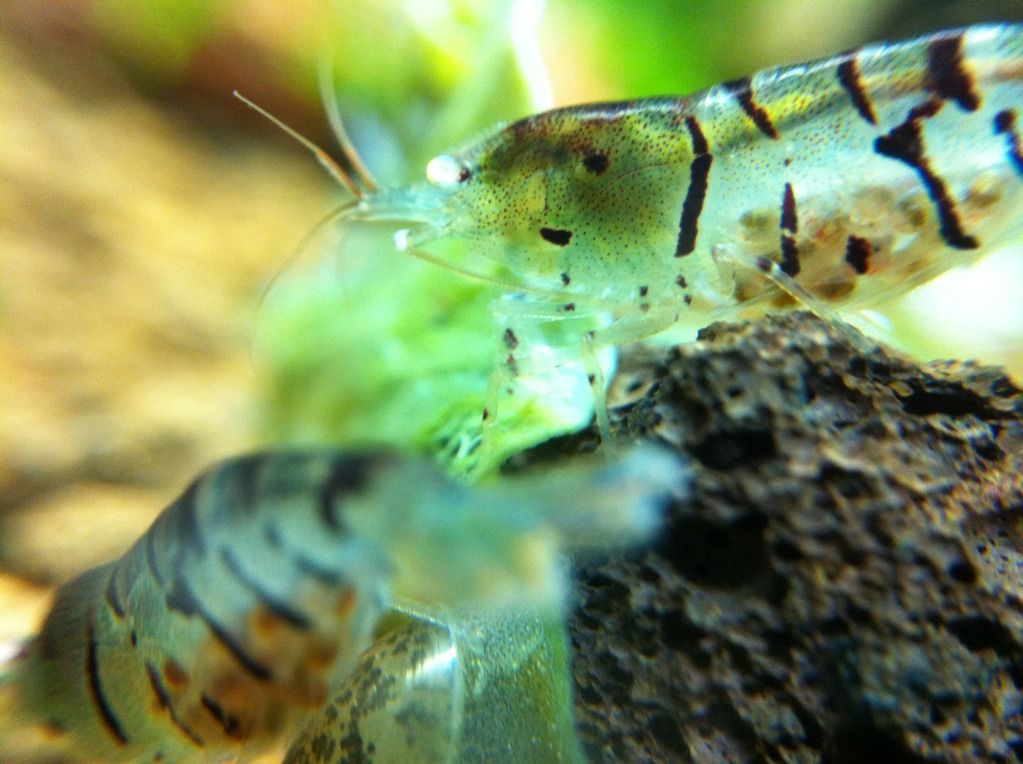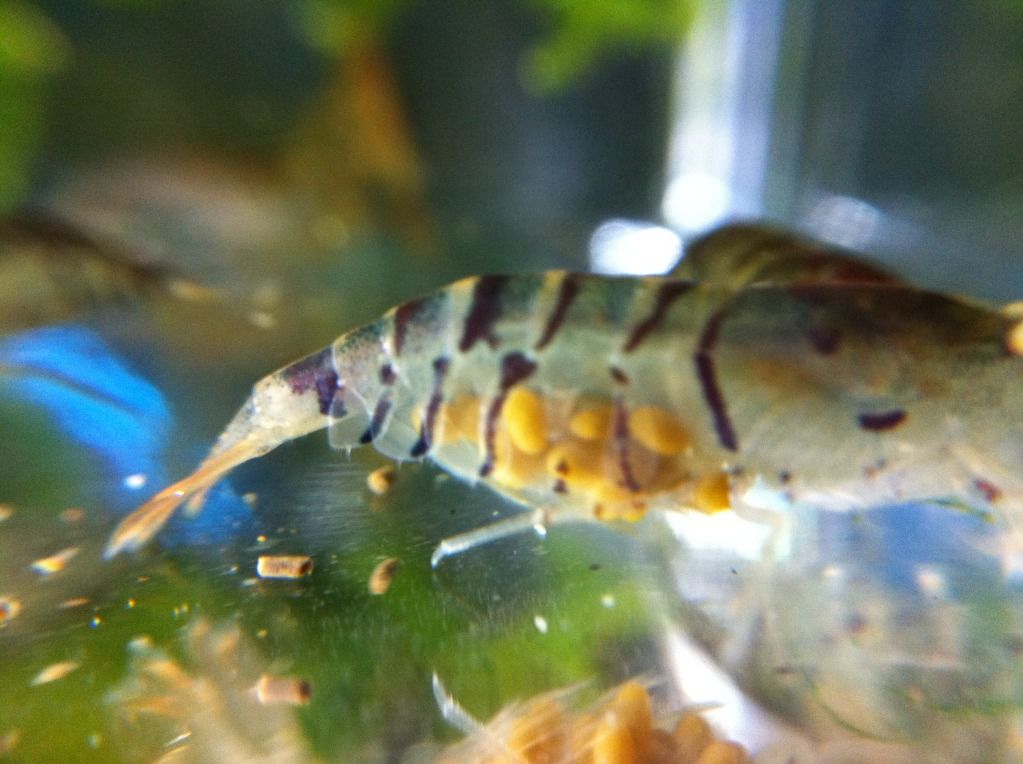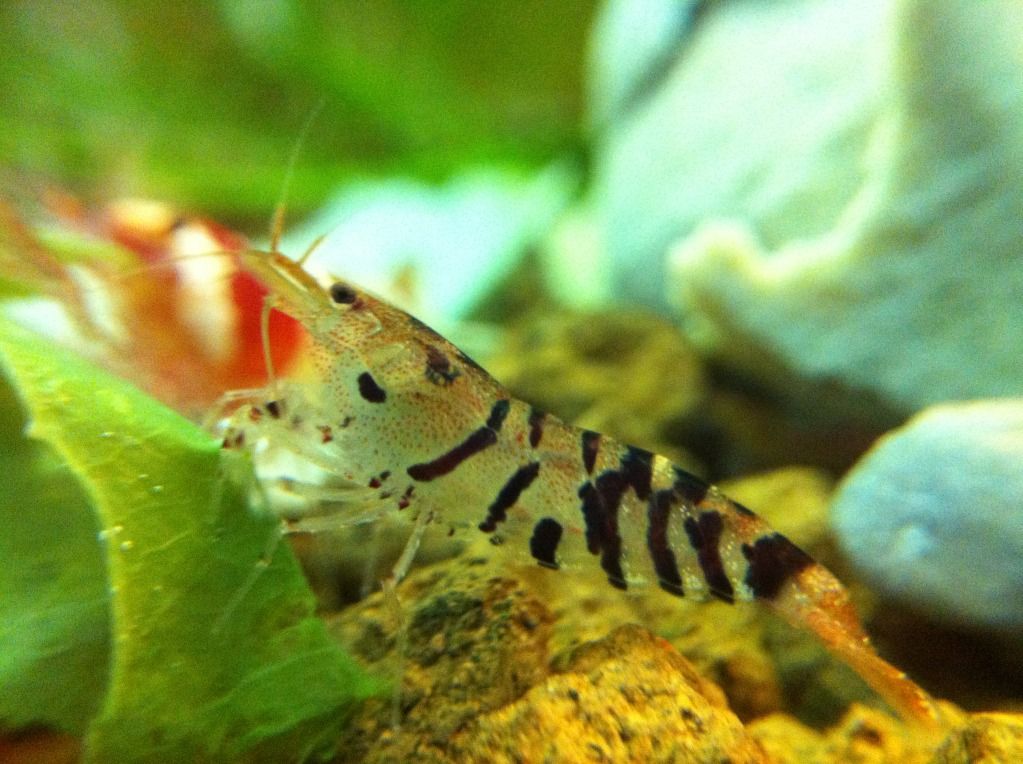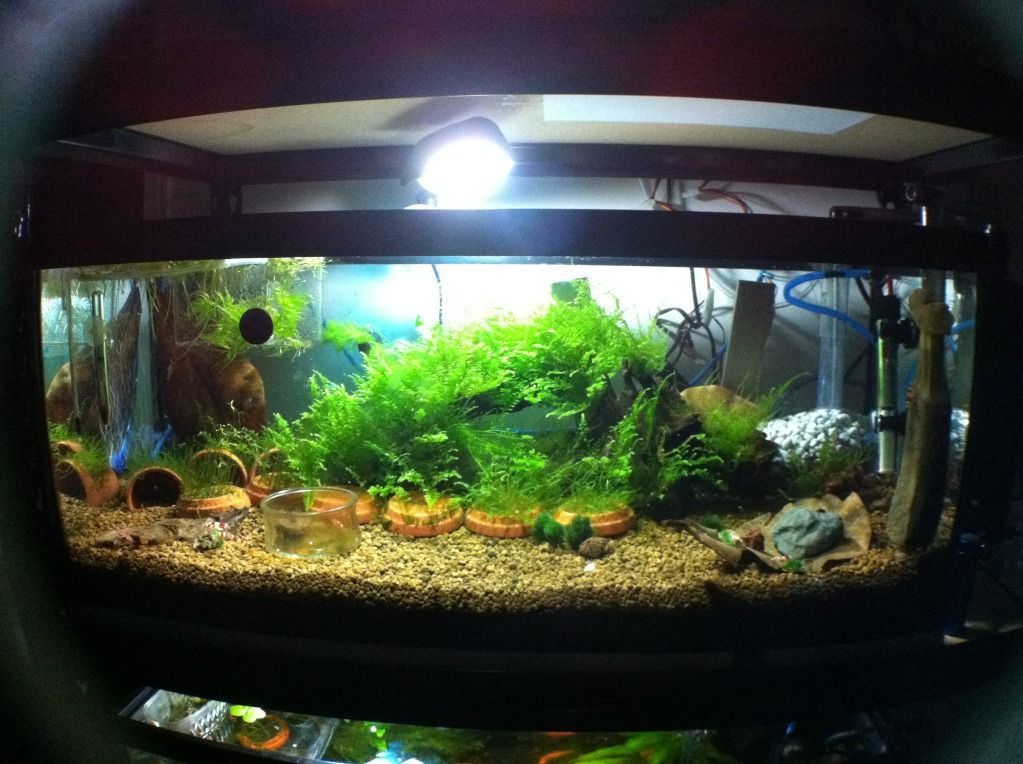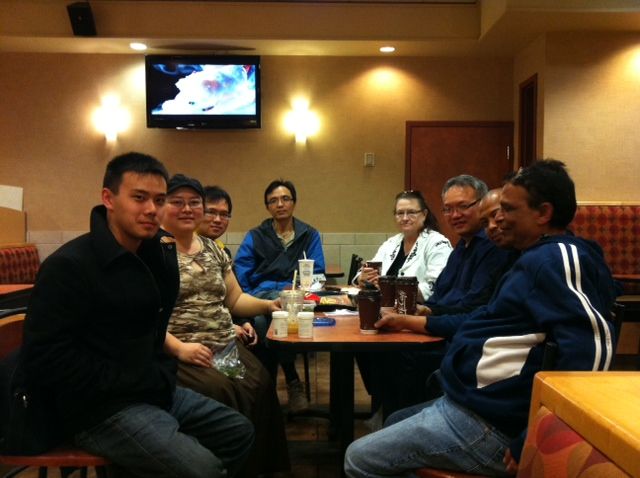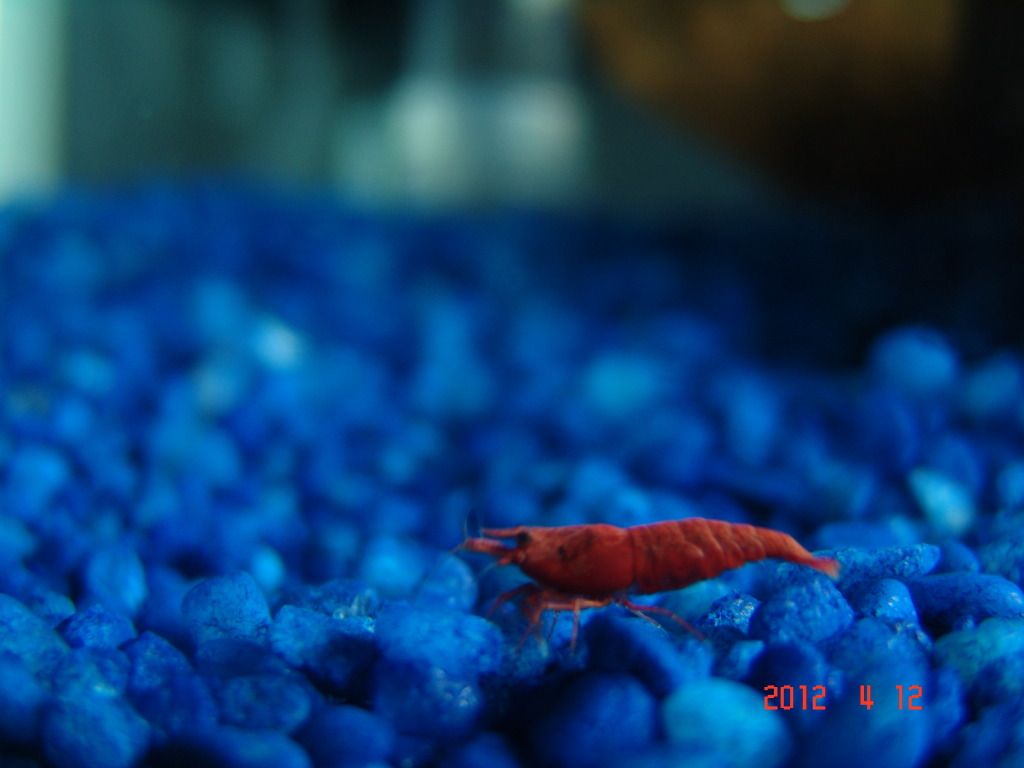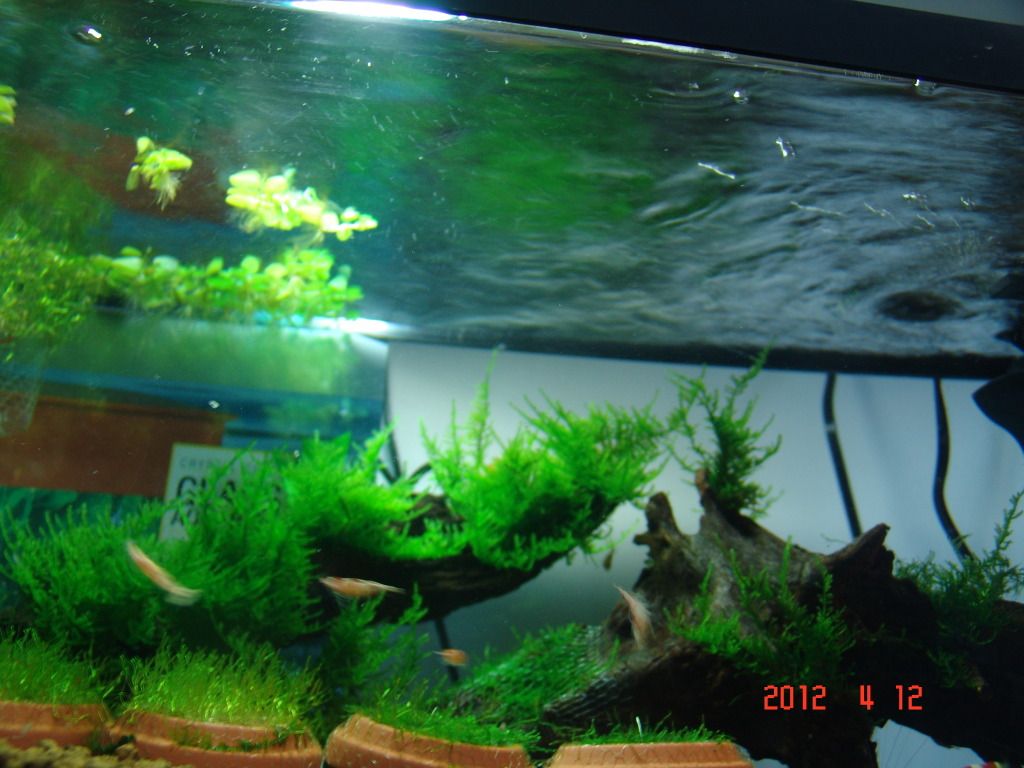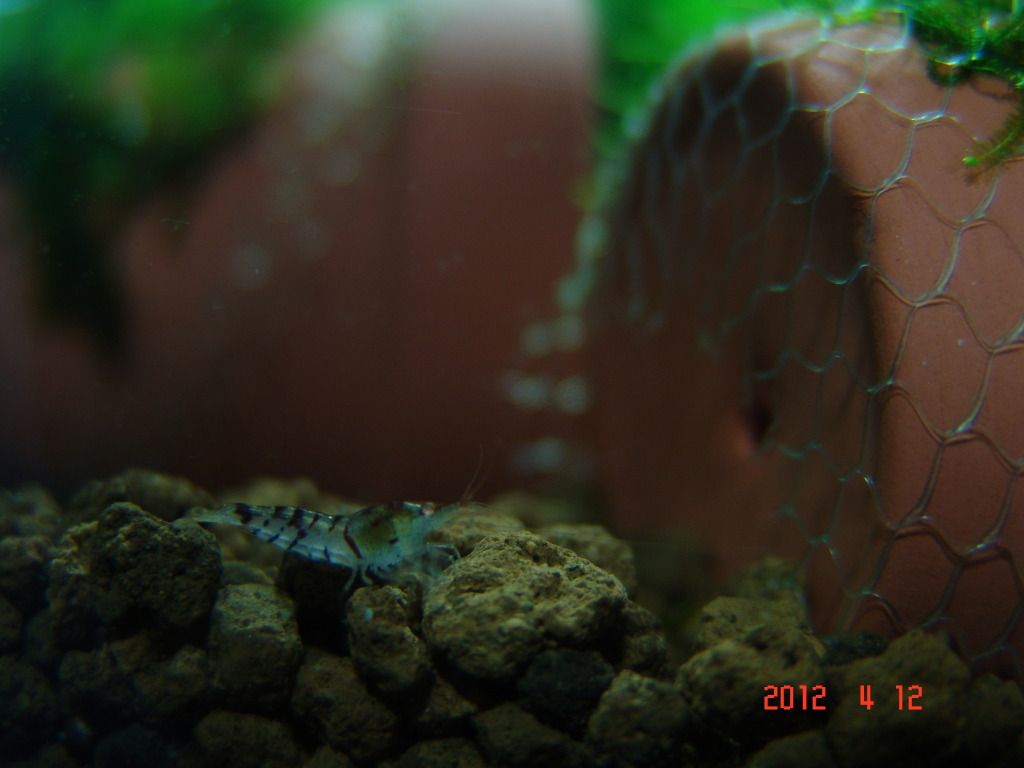Sharing Randy's shrimping experience. ShrimpWaterCube or Shrimp Water Cube is the name I use in some publications and photos.
Monday, August 13, 2012
Crystal White Shrimp
From pictures on internet, they look like snowwhite. But after I see them in person, they do look more like crystal red shrimp with all colour removed. You can see what would be the red no-entry marking on the back except it's like white. The best description is an albino CRS.
BTOE
Got two of these yesterday, their colour put my OEBT, even the best ones, to shame !! In person they look black, but if you get a close look they look deeeeeeep blue. Very nice. Now I wish I had gotten more than two.
Sunday, August 12, 2012
Finally...
These babies are more visible now and I even got a chance to take a few pictures. It's about 10 days after the drop, and they seem to grow very slow comparing to candy canes.
Saturday, August 4, 2012
My triple split 40G
See the tank picture and design on my GTAA post below.
Link to GTAA thread.
Equipment:
40G Breeder tank x 1
Glass divider x 2
Tank lids (two pieces) x 1
Coralife 36" Dual T5NO light (6500K x 1, 6700K x1)
Filtration:
- Fluval 205 x 1 (connected to DIY UGF)
- Fluval slim 15 HOB x 2
Air: part of the output from a Tetra 100. (3 x airstones)
Substrate: 16L of Akadama, medium grain.
Opinions,
- Large amount of water in tank, water very stable.
- Space saving (comparing to 3 individual tanks)
- Water is pretty leveled (sec1 is about 1cm higher than sec2, sec2 1cm higher than sec3) with very good water exchange (tested).
Issues:
- Mistake using the medium grain Akadama, I wish I had at least use 1.25" of smaller grain substrate. The problem with this is that baby shrimps can actually "easily" get to the next section easily. The first CRS dropped the babies in this tank from sec3, and I ended up seeing at least 1 in sec1, 4 or 5 in sec2 LOL
Link to GTAA thread.
Equipment:
40G Breeder tank x 1
Glass divider x 2
Tank lids (two pieces) x 1
Coralife 36" Dual T5NO light (6500K x 1, 6700K x1)
Filtration:
- Fluval 205 x 1 (connected to DIY UGF)
- Fluval slim 15 HOB x 2
Air: part of the output from a Tetra 100. (3 x airstones)
Substrate: 16L of Akadama, medium grain.
Opinions,
- Large amount of water in tank, water very stable.
- Space saving (comparing to 3 individual tanks)
- Water is pretty leveled (sec1 is about 1cm higher than sec2, sec2 1cm higher than sec3) with very good water exchange (tested).
Issues:
- Mistake using the medium grain Akadama, I wish I had at least use 1.25" of smaller grain substrate. The problem with this is that baby shrimps can actually "easily" get to the next section easily. The first CRS dropped the babies in this tank from sec3, and I ended up seeing at least 1 in sec1, 4 or 5 in sec2 LOL
Thursday, August 2, 2012
What do I feed my shrimps?
Do you want to know? I have been experimenting a few things, and have some of my own opinions and suspicion on some common "believes".
So what do I feed them you ask? Tell me what you feed your shrimps first, I'll need to take some pictures before I post mine (which is a mess really)
So what do I feed them you ask? Tell me what you feed your shrimps first, I'll need to take some pictures before I post mine (which is a mess really)
Colours on OEBTs
What I find from my 3 months of keeping OEBTs,
- my tier 1 were all SUPER BLUE when I got them, but 1 or 2 turns almost colourless once in a while, the other keep in a very dark blue colour. Breeding hasn't started (I have had them just less than a month).
- My tier 2 shows the same behaviour. Some keep being blue, a few would change from very blue, light blue (like in the pictures in the post), or blondes. Some of them stay blondes all the time.
- When females are berried, they are likely to lose some blue, but when they are saddled and close to get berried, they become a dark colour and their backs turns almost chocolate, normally they get berried in a few days after that.
- Even their eyes can change colour. I see this on a berried OEBT, her eyes would trun from golden/orange to almost white, but never black.
- One of my berried OEBT turns red (the stripes), that makes it look almost like a red tiger with orange eyes. Not exaggerating here, if you see it, you WILL think it's a red tiger than an OEBT.
What I'm trying to find out
- Can selective breeding achieve stable colour?
- Can I actually get Royal Blue from OEBT x OE Black Tigers?
- What would happen when OEBT x red tiger? or OE Black Tiger x red tiger.
- What is the ratio like when blonde OEBT x blonde OEBT? (probably varies, but at least I want to know if at least I get 30% blue offspring?)
- my tier 1 were all SUPER BLUE when I got them, but 1 or 2 turns almost colourless once in a while, the other keep in a very dark blue colour. Breeding hasn't started (I have had them just less than a month).
- My tier 2 shows the same behaviour. Some keep being blue, a few would change from very blue, light blue (like in the pictures in the post), or blondes. Some of them stay blondes all the time.
- When females are berried, they are likely to lose some blue, but when they are saddled and close to get berried, they become a dark colour and their backs turns almost chocolate, normally they get berried in a few days after that.
- Even their eyes can change colour. I see this on a berried OEBT, her eyes would trun from golden/orange to almost white, but never black.
- One of my berried OEBT turns red (the stripes), that makes it look almost like a red tiger with orange eyes. Not exaggerating here, if you see it, you WILL think it's a red tiger than an OEBT.
What I'm trying to find out
- Can selective breeding achieve stable colour?
- Can I actually get Royal Blue from OEBT x OE Black Tigers?
- What would happen when OEBT x red tiger? or OE Black Tiger x red tiger.
- What is the ratio like when blonde OEBT x blonde OEBT? (probably varies, but at least I want to know if at least I get 30% blue offspring?)
Wednesday, July 25, 2012
Tuesday, June 26, 2012
First berried OEBT
She was highly likely knocked up by a CRS, hope she keeps the eggs. I found this while moving my tanks on the third floor to my basement. Didn't think they are old enough to breed yet. A few more females are as big as this one so hopefully to see more soon.
Monday, June 18, 2012
Sunday, June 17, 2012
Thursday, June 14, 2012
Why?
The 20G L CRS had some newborns a few days ago, I spotted 6 three days ago, then 2 two days ago, only 1 yesterday. It just has to be this hard for me.
Environment:
20 G Long (set up in early March, shrimps introduced in about 4 weeks, it was cycled before shrimps)
Akadama 2" to 2.5"
UGF air driven
Up Aqua EX 120 HOB Canister
One extra airstone
My DIY nitrate filter
13w clipped on CFL light
Tons of peacock and java moss, 1 lone java fern, some amazon frogbits (they haven't been doing well), some hornwort. Two pieces of DW with moss on it, each about 10" x 8".
Temperature: 19 - 23, got up to 24/25 a few times but never stay there for more than 8 hours.
PH 6.5-6.8
TDS 150 - 160
GH 6-8
KH 0-1
NH3/NO2 0
NO3 5-15
20 - 23 adulat CRS low grade
10 OEBT sub-adult
A few more shots on part of the tank,
I have probably lost close to 100 baby CRS by 5 or 6 releases. Adults are fine, OEBTs are thriving and grow fast, and no baby CRS survived more than a week.
I need to move this tank so will have to tear it down. I don't really care that much about the breeding activity in this tank but just can't figure out what is wrong. The shrimps in this tank mostly were put there to wait for the permanent home ready (it was ready 3 days ago).
Environment:
20 G Long (set up in early March, shrimps introduced in about 4 weeks, it was cycled before shrimps)
Akadama 2" to 2.5"
UGF air driven
Up Aqua EX 120 HOB Canister
One extra airstone
My DIY nitrate filter
13w clipped on CFL light
Tons of peacock and java moss, 1 lone java fern, some amazon frogbits (they haven't been doing well), some hornwort. Two pieces of DW with moss on it, each about 10" x 8".
Temperature: 19 - 23, got up to 24/25 a few times but never stay there for more than 8 hours.
PH 6.5-6.8
TDS 150 - 160
GH 6-8
KH 0-1
NH3/NO2 0
NO3 5-15
20 - 23 adulat CRS low grade
10 OEBT sub-adult
A few more shots on part of the tank,
I have probably lost close to 100 baby CRS by 5 or 6 releases. Adults are fine, OEBTs are thriving and grow fast, and no baby CRS survived more than a week.
I need to move this tank so will have to tear it down. I don't really care that much about the breeding activity in this tank but just can't figure out what is wrong. The shrimps in this tank mostly were put there to wait for the permanent home ready (it was ready 3 days ago).
Wednesday, June 13, 2012
Calcium for shrimps
Shrimps need calcium, everyone knows that. They need more calcium because it's the main ingredient in their shell. This is why a lot of shrimp food is advertised as calcium rich.
A few things I gathered from various source, all may not apply but this is what I currently believe in.
What you should avoid or be cautious,
- Too high a GH in water (mainly calcium) is actually bad for shrimp, it will cause molting issue. One theory is that their shell grows so well it's too hard to molt.
- Too low a GH makes molting easier, however, it may also cause issue with shell development.
- Spinach contains high calcium, however, the oxalic acid (草酸) and Fe in spinach are calcium blockers -- they reduce the ability for shrimp to absorb and use the calcium.
What you can do to help calcium intake,
- Vitamin D helps calcium intake. I'm not sure high light helps but researches have been done and prove that longer photo period increases shrimp growth. Here is an interesting paper (http://ntour.ntou.edu.tw/ir/handle/987654321/10676)
- Other vegetables may actually be better for calcium supplement - bok choy, broccoli, cabbage ... etc.
Some other things I have found, tried, or thinking of trying:
Cuttlebone: it's vouched by a lot of shrimp keeper for its benefit to help molting. Since it's cheap and seem harmless, I use it too. But you should know that,
- It does increase the GH/TDS. I added one whole cuttlebone (cut into three pieces) in 500ml of water of TDS 175. After 48 hours, the TDS got to almost 600.
- However, I put one section (1/3 of a whole cuttlebone) into a 6 gallon tank. After 24 hours, there was NO TDS increase.
My conclusion: while it does increase TDS, small amount doesn't have noticeable effect.
BW minerock: I have it in one of my tanks, not sure if it is effective or not. No noticeable difference in that particular tank. It may have increased the molting frequency but I'm not sure if it is due to this. Since I bought some, I use it.
There are lot of other products but hard to get. When I get something new I'll add my experience here.
A few things I gathered from various source, all may not apply but this is what I currently believe in.
What you should avoid or be cautious,
- Too high a GH in water (mainly calcium) is actually bad for shrimp, it will cause molting issue. One theory is that their shell grows so well it's too hard to molt.
- Too low a GH makes molting easier, however, it may also cause issue with shell development.
- Spinach contains high calcium, however, the oxalic acid (草酸) and Fe in spinach are calcium blockers -- they reduce the ability for shrimp to absorb and use the calcium.
What you can do to help calcium intake,
- Vitamin D helps calcium intake. I'm not sure high light helps but researches have been done and prove that longer photo period increases shrimp growth. Here is an interesting paper (http://ntour.ntou.edu.tw/ir/handle/987654321/10676)
- Other vegetables may actually be better for calcium supplement - bok choy, broccoli, cabbage ... etc.
Some other things I have found, tried, or thinking of trying:
Cuttlebone: it's vouched by a lot of shrimp keeper for its benefit to help molting. Since it's cheap and seem harmless, I use it too. But you should know that,
- It does increase the GH/TDS. I added one whole cuttlebone (cut into three pieces) in 500ml of water of TDS 175. After 48 hours, the TDS got to almost 600.
- However, I put one section (1/3 of a whole cuttlebone) into a 6 gallon tank. After 24 hours, there was NO TDS increase.
My conclusion: while it does increase TDS, small amount doesn't have noticeable effect.
BW minerock: I have it in one of my tanks, not sure if it is effective or not. No noticeable difference in that particular tank. It may have increased the molting frequency but I'm not sure if it is due to this. Since I bought some, I use it.
There are lot of other products but hard to get. When I get something new I'll add my experience here.
Thursday, May 24, 2012
There's no end
So, my previous issue with the 7.5G seems to have disappeared after changing a few things. I've been busy at work/family/fishing and it's been really hard to find time to do what I need to do. The tanks in the basement are cycling, NO2 has shown for more than a week but no sign of easing off. Netlea tank still leaching NH3 after, hmm... almost 3 months. Then my main CRS/OEBT tank is giving me trouble.
The shrimp in the 20GL tank has been acting funny. Monday when I fed them, although they still came for spinach but after 10 minutes most just wondered off. And from then on, they started to be very inactive. No dead shrimps are found yet but I really can't tell if the bodies were just eaten (probably not by the way they respond to food). However, all baby CRS are goners now. It does make the tank move planned in about a week to 2 weeks easier I guess.
Also, I saw ONE hydra and ONE very small planaria-like creature. So I dosed panacur Tuesday night... then last night.... they became really inactive, and I tested NH3 0 (or very close to 0, I always have trouble comparing the yellows of different shade), NO2 0, and then... NO3 somewhere between 70 to 80. OMG.... what's going on. Did 10% WC and got more ROs to do a 30% WC today. So much for the panacur dosing but that can wait. Not sure now if planarias got to the baby CRS or the NO3. I'll deal with NO3 first.
I'll do a few daily 10%-30% WC until NO3 comes down to 20% then add the DIY NO3 reactor with Seachem deNitrate. Sigh... this is not as easy as I thought it would be after a few months.
The shrimp in the 20GL tank has been acting funny. Monday when I fed them, although they still came for spinach but after 10 minutes most just wondered off. And from then on, they started to be very inactive. No dead shrimps are found yet but I really can't tell if the bodies were just eaten (probably not by the way they respond to food). However, all baby CRS are goners now. It does make the tank move planned in about a week to 2 weeks easier I guess.
Also, I saw ONE hydra and ONE very small planaria-like creature. So I dosed panacur Tuesday night... then last night.... they became really inactive, and I tested NH3 0 (or very close to 0, I always have trouble comparing the yellows of different shade), NO2 0, and then... NO3 somewhere between 70 to 80. OMG.... what's going on. Did 10% WC and got more ROs to do a 30% WC today. So much for the panacur dosing but that can wait. Not sure now if planarias got to the baby CRS or the NO3. I'll deal with NO3 first.
I'll do a few daily 10%-30% WC until NO3 comes down to 20% then add the DIY NO3 reactor with Seachem deNitrate. Sigh... this is not as easy as I thought it would be after a few months.
Tuesday, May 15, 2012
Too much filtration?
A discussion on TPT got me thinking, actually I've been thinking about this topic for a while.
So, here it is. It's very popular in Asia shrimp keeping circle to have multiple canister filters connected to get more filtration. But, if I only need 1 to get NH3/NO2 to 0, and NO3 is under control, what does the extra filtration give me?
So, here it is. It's very popular in Asia shrimp keeping circle to have multiple canister filters connected to get more filtration. But, if I only need 1 to get NH3/NO2 to 0, and NO3 is under control, what does the extra filtration give me?
Monday, May 14, 2012
RIP
The last CRS I got from a unnamed source (since source has nothing to do with what's happened) has died yesterday. I got 5 early February.
- the biggest female died 3 weeks after I got them. I was playing with the heater in that 2.5G and I think I killed trying to up the temperature in the winter temperature.
- I started to see them dying slowing one by one in the last month. In a 7.5G tank that has the best water quality, NH3/NO2 are zero all the time, NO3 hasn't gone over 5ppm.
- Last one died yesterday.
As mentioned above, the tank has pretty good water quality. It's a 7.5G with a Fluval 105 adjust to about 50-70GPH connected to UGF with Akadama substrate.
I have about 8 to 9 mischling shrimps (one died after about 2 weeks), a trio of orange neo that never stop breeding, and these CRS from AI.
Lighting is a 13w CFL with a clipped on light, about 10 hr/day. Good amount of java moss and some flame moss, plus some floaters (the only tank I have that has these floater grows nicely).
All seem good while this is the only tank I'm seeing dead shrimp. Over populated? I'm not sure. The orange trio did give birth to somewhere between 30 to 50 baby shrimps. The second drop (both female, about the same time) seem to have very low survival rate, they were dropped at around the same time I started to see dead shrimps. Hope it will be good from now on, fingers crossed.
- the biggest female died 3 weeks after I got them. I was playing with the heater in that 2.5G and I think I killed trying to up the temperature in the winter temperature.
- I started to see them dying slowing one by one in the last month. In a 7.5G tank that has the best water quality, NH3/NO2 are zero all the time, NO3 hasn't gone over 5ppm.
- Last one died yesterday.
As mentioned above, the tank has pretty good water quality. It's a 7.5G with a Fluval 105 adjust to about 50-70GPH connected to UGF with Akadama substrate.
I have about 8 to 9 mischling shrimps (one died after about 2 weeks), a trio of orange neo that never stop breeding, and these CRS from AI.
Lighting is a 13w CFL with a clipped on light, about 10 hr/day. Good amount of java moss and some flame moss, plus some floaters (the only tank I have that has these floater grows nicely).
All seem good while this is the only tank I'm seeing dead shrimp. Over populated? I'm not sure. The orange trio did give birth to somewhere between 30 to 50 baby shrimps. The second drop (both female, about the same time) seem to have very low survival rate, they were dropped at around the same time I started to see dead shrimps. Hope it will be good from now on, fingers crossed.
Cycling Netlea tank
I posted this at GTAA, thought I'd post it in my blog for my own future reference.
I am not famous for my patience, but cycling a tank isn't something I would skip on. I posted around 2 months ago about the three 20GL tanks I set up around the same time with different substrates. I learned a lot from that experiment.
Now, I want to share something about cycling a tank with Netlea (or anything similar). Before I start, I want to refer to some basics, read them if you're not sure how/why to cycle a tank.
Wikipedia's short description on Nitrifying bacteria
So, basically you want to make sure your tank has enough ammonia-oxidizing bacteria (AOB) to handle the ammonia produced by your shrimps and convert them to nitrite, and have enough nitrite-oxidizing bacteria (NOB) to convert the nitrite to nitrate.
The end result of a cycled tank is that you have enough AOB + NOB so ammonia and nitrite never will appear in your tank in dangerous concentration.
So
Ammonia (from shrimp) turns into Nitrite by AOB
Nitrite (from above process) turns into Nitrate by NOB
(How to get rid of Nitrate is not discussed in this post, maybe later)
Okay, that's basics and most of us already are very familiar with, and we have discussed a lot of things about how to do it fishlessly, either with rotting fish food, raw shrimp, or pure ammonia.
What else can help the establishment of AOB and NOB? (i.e. speed up the cycling process) These bacterias are known to spawn slower than others because they can't utilize organic food source, very unique in their own right, but the following help,
- Higher temperature (most bacterias grows faster in higher temperature)
- Higher PH (7.8+ is better)
- Higher oxygen concentration
- And of course, proper amount of food source (i.e. ammonia, but not too much, 4 to 5 ppm is about the highest, anything more actually kills these bacteria).
Okay, it's already been a long post but I haven't even touched my main topic. In my new Netlea tank set up 2 months ago, I had a big issue with the cycling process -- the PH is just way too low... it was about 5.3 when new and then gradually goes up to 5.7/5.8 after a few weeks and a few big WCs. In that kind of PH, AOB just can't establish. The reason is one, they don't like acidic water, two, at PH lower than 6.4 almost all ammonia turns into ammonum which these AOB is not very efficient in using. In my first 6 weeks of cycling, I have only tested NO2 once in low concentration. It's entirely possible that the tank was ready after that point since ammonia isn't likely to be present in that kind of PH but I took it more as an experiment than getting the tank ready for shrimp. After 2 months, there's no change, there just isn't any NO2 detected and very low NO3. I actually would put shrimp in there because from others' experience it should be safe, but I wanted to see how long it will be before I see the common signs of a cycled tank.
Anyway, about a week ago, I moved the tank to my basement and moved the Netlea from the 1x 20GL to 2x 16G (the floor areas are about equal). After a day with new tap water, the PH stayed up. One was 6.9 the other was 7.1. What the heck?! I thought by moving them to different tanks I destroyed them. I then thought maybe it's because I was using UGF in the 20GL but not in the 2 x 16G. So I bought a small double layer UGF from AI and put it in one of the two tanks. Guess what? PH dropped from 6.8 to 6.2 in 2 hours. Then it struck me -- I disconnected the UGF, then did some WC to get the PH back to near 7, turn on the heat, and started cycling. I think this should help and this will be the way I cycle these high PH lowering substrate from now on. I will connect the UGF to bring down PH to what I want after the tank is cycled.
Sorry for the long post, just something I learned the past week and may not be of any value. Hope I didn't waste your time.
I am not famous for my patience, but cycling a tank isn't something I would skip on. I posted around 2 months ago about the three 20GL tanks I set up around the same time with different substrates. I learned a lot from that experiment.
Now, I want to share something about cycling a tank with Netlea (or anything similar). Before I start, I want to refer to some basics, read them if you're not sure how/why to cycle a tank.
Wikipedia's short description on Nitrifying bacteria
So, basically you want to make sure your tank has enough ammonia-oxidizing bacteria (AOB) to handle the ammonia produced by your shrimps and convert them to nitrite, and have enough nitrite-oxidizing bacteria (NOB) to convert the nitrite to nitrate.
The end result of a cycled tank is that you have enough AOB + NOB so ammonia and nitrite never will appear in your tank in dangerous concentration.
So
Ammonia (from shrimp) turns into Nitrite by AOB
Nitrite (from above process) turns into Nitrate by NOB
(How to get rid of Nitrate is not discussed in this post, maybe later)
Okay, that's basics and most of us already are very familiar with, and we have discussed a lot of things about how to do it fishlessly, either with rotting fish food, raw shrimp, or pure ammonia.
What else can help the establishment of AOB and NOB? (i.e. speed up the cycling process) These bacterias are known to spawn slower than others because they can't utilize organic food source, very unique in their own right, but the following help,
- Higher temperature (most bacterias grows faster in higher temperature)
- Higher PH (7.8+ is better)
- Higher oxygen concentration
- And of course, proper amount of food source (i.e. ammonia, but not too much, 4 to 5 ppm is about the highest, anything more actually kills these bacteria).
Okay, it's already been a long post but I haven't even touched my main topic. In my new Netlea tank set up 2 months ago, I had a big issue with the cycling process -- the PH is just way too low... it was about 5.3 when new and then gradually goes up to 5.7/5.8 after a few weeks and a few big WCs. In that kind of PH, AOB just can't establish. The reason is one, they don't like acidic water, two, at PH lower than 6.4 almost all ammonia turns into ammonum which these AOB is not very efficient in using. In my first 6 weeks of cycling, I have only tested NO2 once in low concentration. It's entirely possible that the tank was ready after that point since ammonia isn't likely to be present in that kind of PH but I took it more as an experiment than getting the tank ready for shrimp. After 2 months, there's no change, there just isn't any NO2 detected and very low NO3. I actually would put shrimp in there because from others' experience it should be safe, but I wanted to see how long it will be before I see the common signs of a cycled tank.
Anyway, about a week ago, I moved the tank to my basement and moved the Netlea from the 1x 20GL to 2x 16G (the floor areas are about equal). After a day with new tap water, the PH stayed up. One was 6.9 the other was 7.1. What the heck?! I thought by moving them to different tanks I destroyed them. I then thought maybe it's because I was using UGF in the 20GL but not in the 2 x 16G. So I bought a small double layer UGF from AI and put it in one of the two tanks. Guess what? PH dropped from 6.8 to 6.2 in 2 hours. Then it struck me -- I disconnected the UGF, then did some WC to get the PH back to near 7, turn on the heat, and started cycling. I think this should help and this will be the way I cycle these high PH lowering substrate from now on. I will connect the UGF to bring down PH to what I want after the tank is cycled.
Sorry for the long post, just something I learned the past week and may not be of any value. Hope I didn't waste your time.
Friday, May 11, 2012
Defeated?
I'm just having too many issues with this hobby lately. Setting up a few more tanks in the basement and need to come up with lighting, heating, filtration solutions, moving established tanks to the basement and got all weird things happening to water parameters.
When you see people's setup running, you are not seeing so many small things that the owners have to deal with. Unless you choose not to care, there's no end to it.
On top of the tank moving/setting up fiasco, I'm starting to encounter challenges in this hobby. My PFR population somehow stalls, I'm not seeing shrimplets from my two female oranges' last hatch about a week ago. A nicer CRS I've kept for 3 months decided to jump out of the tank and died on the floor, and I've had 2 dead shrimps in that same tank in the last two weeks, which bring my all-time total dead shrimps in tank to 3.
Am I defeated? No. I'm just finding out what I'm not.
Ecclesiastes 3:11 He hath made everything beautiful in its time: also he hath set eternity in their heart, yet so that man cannot find out the work that God hath done from the beginning even to the end.
When you see people's setup running, you are not seeing so many small things that the owners have to deal with. Unless you choose not to care, there's no end to it.
On top of the tank moving/setting up fiasco, I'm starting to encounter challenges in this hobby. My PFR population somehow stalls, I'm not seeing shrimplets from my two female oranges' last hatch about a week ago. A nicer CRS I've kept for 3 months decided to jump out of the tank and died on the floor, and I've had 2 dead shrimps in that same tank in the last two weeks, which bring my all-time total dead shrimps in tank to 3.
Am I defeated? No. I'm just finding out what I'm not.
Ecclesiastes 3:11 He hath made everything beautiful in its time: also he hath set eternity in their heart, yet so that man cannot find out the work that God hath done from the beginning even to the end.
Saturday, May 5, 2012
Saturday, April 28, 2012
First CRS babies
I got home after work yesterday and found two surprises. One was that my Golden Apple snails laid some egges on the tank wall above water where I laid a piece of glass on top, counted about 20-30 eggs.
Secondly, I got some CRS from Ricky on March 29 and found one berried female two days later. I thought it should be any day now and I was so happy to find one CRS baby (I was looking for one). Didn't have time to try to find more because I had a church small group meeting in the evening. Came home fro church and I could see 4 to 5 in sight, I're sure there are more as even they are right in front of me I can hardly see them if they don't move.
Baby CRS are very different from baby Neos in that they hatched as small miniature CRS with colour, where as Neo babies hatched colourless and won't develop any colour until 10 to 14 days old, and colouration gradually develops.
Anyway... so happy Thanks God for these baby shrimps. There are 3 or 4 berried females in the tank and one or two of them should release in the next few days.
Secondly, I got some CRS from Ricky on March 29 and found one berried female two days later. I thought it should be any day now and I was so happy to find one CRS baby (I was looking for one). Didn't have time to try to find more because I had a church small group meeting in the evening. Came home fro church and I could see 4 to 5 in sight, I're sure there are more as even they are right in front of me I can hardly see them if they don't move.
Baby CRS are very different from baby Neos in that they hatched as small miniature CRS with colour, where as Neo babies hatched colourless and won't develop any colour until 10 to 14 days old, and colouration gradually develops.
Anyway... so happy Thanks God for these baby shrimps. There are 3 or 4 berried females in the tank and one or two of them should release in the next few days.
Tuesday, April 17, 2012
Random facts in water parameters (updated 2012/04/17)
General:
- 0.1ppm of NO2 is considered the limit for aquatic animal safety.
- 0.2ppm of NH3 is considered the limit for aquatic animal safety.
NO2-
- NO2 toxin isn't affected by temperature, and isn't affected much by PH. (4)
- But some says the the toxin of NO2 isn't affected much by temperature in basic water only. (3)
- NO2 toxin reduces as GH increases. (4)
- NO2 is more toxic when dissolved oxygen is lower (NO2 affects oxygen carrying, lower DO in higher temperature)
- NO2 is slightly acidic, in low PH it more easily formed.
Shrimping Conclusion : not much we can do other than make sure bacteria is establish to convert NO2- to NO3-.
NH3:
- NH3 is more toxic when temperature or PH is higher
PH:
- Low PH affects oxygen carrying ability. (Shrimps need more DO to compensate low PH).
- High PH affects gill ability and can cause problem.
Reference: (some in Chinese)
1. http://www.chinaas.cn/technic/Detail.action?id=ff808081365ef9720136813d81af044d
2. http://www.njrsc.net/yztx/html/?99.html
3. http://www.yjhtyz.com/s04/yjhtyz/jswz/20111217/545797.html
4. http://www.laoshan.gov.cn/n206250/n194245/n1580597/n12024377/n12024378/12025572.html
- 0.1ppm of NO2 is considered the limit for aquatic animal safety.
- 0.2ppm of NH3 is considered the limit for aquatic animal safety.
Shrimping Conclusion :
- NO2 and NH3 should always be 0.NO2-
- NO2 toxin isn't affected by temperature, and isn't affected much by PH. (4)
- But some says the the toxin of NO2 isn't affected much by temperature in basic water only. (3)
- NO2 toxin reduces as GH increases. (4)
- NO2 is more toxic when dissolved oxygen is lower (NO2 affects oxygen carrying, lower DO in higher temperature)
- NO2 is slightly acidic, in low PH it more easily formed.
Shrimping Conclusion : not much we can do other than make sure bacteria is establish to convert NO2- to NO3-.
NH3:
- NH3 is more toxic when temperature or PH is higher
Shrimping Conclusion:
- Be alerted when it gets too warm, NH3 can be a bigger issue.
- Lower PH to minimize NH3 toxin (NH3 -> NH4)PH:
- Low PH affects oxygen carrying ability. (Shrimps need more DO to compensate low PH).
- High PH affects gill ability and can cause problem.
Shrimpping Conclusion:
- Make sure water is well aerated in low PH tank.Reference: (some in Chinese)
1. http://www.chinaas.cn/technic/Detail.action?id=ff808081365ef9720136813d81af044d
2. http://www.njrsc.net/yztx/html/?99.html
3. http://www.yjhtyz.com/s04/yjhtyz/jswz/20111217/545797.html
4. http://www.laoshan.gov.cn/n206250/n194245/n1580597/n12024377/n12024378/12025572.html
Friday, April 13, 2012
PFR
One of my PFRs, I have to say I have better ones but this gal came to the front of the tank for a photo op while all others hid in the back. Not having a macro lens really limits what I can do with the photos.
Breeding frenzy
The CRS I got from Ricky have been in breeding frenzy. I count 4 berried today and male shrimps are still flying. May (and hope to) see more berried mama tomorrow. I got these from Ricky on March 29, one got berried the day after. So by end of April I should see some babies.
And see the males going crazy looking for newly molted females.
And see the males going crazy looking for newly molted females.
First OEBT
My first OEBT, I got 11 of these plus 10 mischling. One of the mischling looks like a panda. But it's still small to tell. I got these on April 11, 2012.
Monday, April 2, 2012
For my short term memory ...
I don't want to keep looking up these terms. Will keep updating, let me know if you find something that should be added here.
Japanese lines
Hikata/HKT 博多蝦
Nishikiebi /NSK 錦蝦
MunEchika Fish Farm/MFF ??
Taiwanese lines
Yuken, YU CRS Centre
Canadian lines
EbiLei (well, that's me ;-)
Japanese lines
Hikata/HKT 博多蝦
Nishikiebi /NSK 錦蝦
MunEchika Fish Farm/MFF ??
Taiwanese lines
Yuken, YU CRS Centre
Canadian lines
EbiLei (well, that's me ;-)
Friday, March 30, 2012
Blog, me? Not in the wildest dream, but here I am. I'll see how this goes...
Subscribe to:
Comments (Atom)
